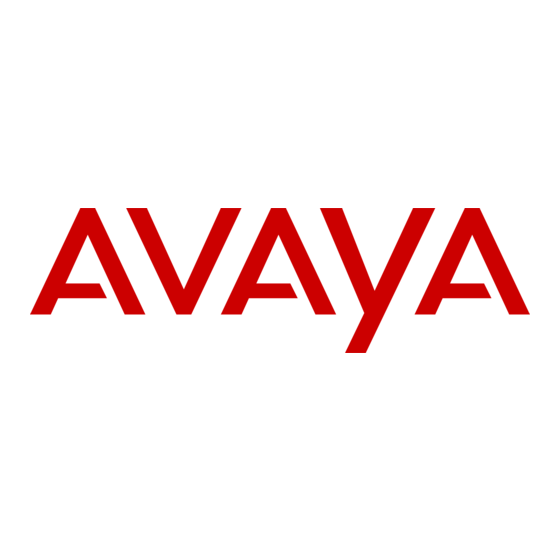Avaya H209 Handbuch - Seite 4
Blättern Sie online oder laden Sie pdf Handbuch für Telefon Avaya H209 herunter. Avaya H209 19 Seiten. Installing and administering
Auch für Avaya H209: Handbuch verwenden (19 seiten)

Regulatory Statements
Australia Statements
Handset Magnets Statement:
Danger:
The handset receiver contains magnetic devices that can
attract small metallic objects. Care should be taken to avoid
personal injury.
Industry Canada (IC) Statements
This Class B digital apparatus complies with Canadian ICES-003.
Cet appareil numérique de la classe B est conformeà la norme
NMB-003 du Canada.
This product meets the applicable Innovation, Science and Economic
Development Canada technical specifications.
Japan Statements
Class B Statement
This is a Class B product based on the standard of the VCCI Council.
If this is used near a radio or television receiver in a domestic
environment, it may cause radio interference. Install and use the
equipment according to the instruction manual.
México Statement
The operation of this equipment is subject to the following two
conditions:
1. It is possible that this equipment or device may not cause
harmful interference, and
2. This equipment or device must accept any interference,
including interference that may cause undesired operation.
La operación de este equipo está sujeta a las siguientes dos
condiciones:
1. Es posible que este equipo o dispositivo no cause
interferencia perjudicial y
2. Este equipo o dispositivo debe aceptar cualquier
interferencia, incluyendo la que pueda causar su operación
no deseada.
Brazil Statement
Este equipamento não tem direito à proteção contra interferência
prejudicial e não pode causar interferência em sistemas devidamente
autorizados
Taiwan Statements
低功率電波輻射性電機管理辦法
第十二條:經型式認證合格之低功率射頻電機,非經許可,公司、商號
或使用者均不得擅自變更頻率、加大功率或變更原設計之特性及功
能。
第十四條:低功率射頻電機之使用不得影響飛航安全及干擾合法通信;
經發現有干擾現象時,應立即停用,並改善至無干擾時方得繼續使
用。
前項合法通信,指依電信法規定作業之無線電通信。
低功率射頻電機須忍受合法通信或工業、科學及醫療用電波輻射性電
機設備之干擾。
U.S. Federal Communications Commission (FCC) Statements
Compliance Statement
The changes or modifications not expressly approved by the party
responsible for compliance could void the user's authority to operate
the equipment.
To comply with the FCC RF exposure compliance requirements, this
device and its antenna must not be co-located or operating to
conjunction with any other antenna or transmitter.
This device complies with part 15 of the FCC Rules. Operation is
subject to the following two conditions:
1. This device may not cause harmful interference, and
2. This device must accept any interference received,
including interferences that may cause undesired
operation.
Class B Part 15 Statement
This equipment has been tested and found to comply with the limits
for a Class B digital device, pursuant to Part 15 of the FCC Rules.
These limits are designated to provide reasonable protection against
harmful interferences in a residential installation. This equipment
generates, uses and can radiate radio frequency energy and, if not
installed and used in accordance with the instructions, may cause
harmful interference to radio communications. However, there is no
guarantee that interference will not occur in a particular installation. If
this equipment does cause harmful interferences to radio or
television reception, which can be determined by turning the
equipment off and on, the user is encouraged to try to correct the
interference by one or more of the following measures:
• Reorient or relocate the receiving antenna.
• Increase the separation between the equipment and receiver.
• Connect the equipment into an outlet on a circuit different from
that to which the receiver is connected.
• Consult the dealer or an experienced radio/TV technician for
help.
EU Countries
This device when installed complies with the essential requirements
and other relevant provisions of EMC Directive 2014/30/EU and LVD
Directive 2014/35/EU. A copy of the Declaration may be obtained
from
https://support.avaya.com
Parkway, Santa Clara, CA 95054–1233 USA.
Public Switch Telephone Network (PSTN)
This equipment is not be connected to the PSTN or other outside
lines. Connection to the PSTN or outside line may result Electrical
Shock Hazard to Users and potential damage equipment and to the
outside line.
General Safety Warning
Ensure that you are familiar with the following safety guidelines:
• Be aware of the hazards involved with electrical circuitry and
be familiar with standard practices for preventing accidents.
• Use the external power supply that is included in the package.
Using another power supply might cause damage to the
phone or affect its reliability.
• Before using the external power supply, check the power
voltage to ensure it is compatible.
• Ensure that the power cord or plug is not damaged.
• Do not drop, knock, or shake the phone. Rough handling can
break internal circuit boards.
• Do not expose the phone to direct sunlight as the phone is
designed for indoor use.
• Do not put the phone on carpets or cushions.
• Do not expose the phone to high temperatures, low
temperatures below 0°C (32°F), or high humidity.
• Do not wet the device with any liquid.
• Do not use harsh chemicals, cleaning solvents, or strong
detergents to clean the device. Wipe the device with a soft
cloth that is slightly dampened with water and a mild soap
solution.
• Do not attempt to open the device. Non-expert handling of the
device can cause a fire, electric shock, or breakdown.
• During a thunderstorm, do not touch the power plug. Lightning
can cause electric shocks.
or Avaya Inc., 4655 Great America
